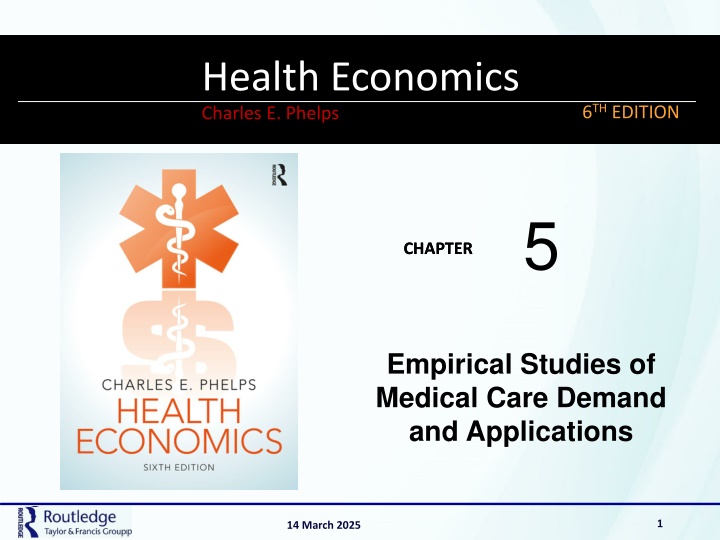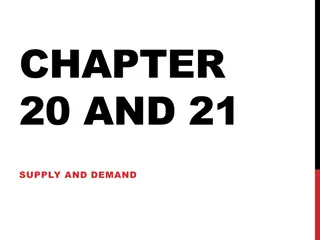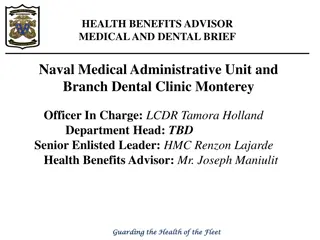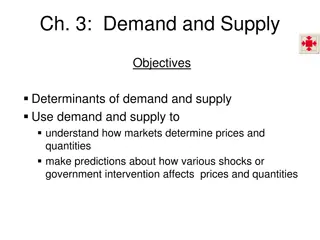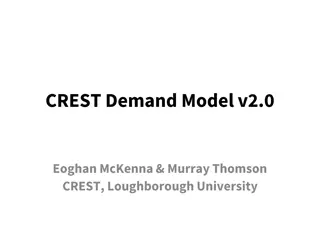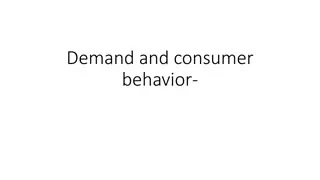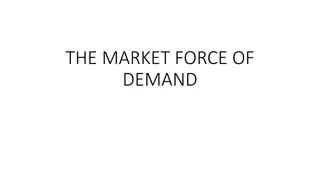Studies of Medical Care Demand Elasticities
Learn about the RAND Health Insurance Study in the 1970s, which provided valuable insights into price elasticity of demand for medical care. Explore how different insurance plans and financial incentives impact individuals' choices in seeking medical services.
Download Presentation

Please find below an Image/Link to download the presentation.
The content on the website is provided AS IS for your information and personal use only. It may not be sold, licensed, or shared on other websites without obtaining consent from the author.If you encounter any issues during the download, it is possible that the publisher has removed the file from their server.
You are allowed to download the files provided on this website for personal or commercial use, subject to the condition that they are used lawfully. All files are the property of their respective owners.
The content on the website is provided AS IS for your information and personal use only. It may not be sold, licensed, or shared on other websites without obtaining consent from the author.
E N D
Presentation Transcript
MODERN LABOR ECONOMICS THEORY AND PUBLIC POLICY Charles E. Phelps Health Economics 12THEDITION 6THEDITION 5 CHAPTER CHAPTER Empirical Studies of Medical Care Demand and Applications 1 14 March 2025
Learning Goals Understand the distinction between a model (as in Chapter 4) and evidence (as in this chapter). Gain at least a general understanding of the magnitude of demand elasticities for medical care of various types. Understand how specific variables (age, illness, income, and lifestyle) affect demand for medical care. See how cross-price elasticities (e.g., drugs and acute medical care) can matter. Apply consumer demand models and evidence to measure the economic importance of medical practice variations. 14 March 2025 2
5.1 Studies of Demand Curves The Rand HIS Studies during the 1970s provided a wide range of estimates of price elasticity of demand for hospital days, medical services, etc. In the mid-1970s the RAND Health Insurance Study (HIS) was launched. Considered the gold standard of evidence of the effects of price on the demand for medical care. A total of 5,809 enrollees was chosen from four cities and two rural sites, asked to participate for either three or five years, for a total number of person-years of 20,190. At enrollment, the persons were told which of the following insurance plans they would use: (1) full coverage (C = 0) for all services; (2) 25 percent copayment (C = 0.25) for all services; (3) 50 percent copayment (C = 0.50) for all services; (4) 50 percent copayment for dental and mental services (C = 0.25 for other care, C = 0.50 for dental and mental services); (5) an individual deductible for ambulatory care only of $150 per person in the family ($450 total per family); and (6) essentially no coverage until a catastrophic cap had been reached (5, 10, or 15 percent of family income, subject to an overall maximum of $1,000). 14 March 2025 3
5.1 Studies of Demand Curves The Rand HIS, continued In every plan, the enrollees had a cap on financial risk, which gave an incentive to enroll. Also a participation payment incentive The primary results compared means across the plans, the simplest approach, and one allowed by the randomized-trial design. The use of regression analysis to control for other factors increased the precision of the estimates and shows the effects of other variables (such as age and income) that are explored shortly. Table 5.1 (following slide) shows the basic results for outpatient care and total medical spending. Table 5.2 and 5.3 (following slide) converts these data into arc elasticities (elasticity between two points on a demand curve). 14 March 2025 4
5.1 Studies of Demand Curves 14 March 2025 5
5.1 Studies of Demand Curves 14 March 2025 6
5.1 Studies of Demand Curves The Rand HIS, continued Keeler et al. (1988) broke down the price response into the number of episodes and the spending per episode. Table 5.3 (previous slide) shows the arc-elasticities broken down more finely by type of care received. In general, the price responsiveness of medical services was still fairly small, but it is larger than the simple comparison of plan means shows. The patterns of demand elasticities correspond to intuition about medical necessity. Demand for hospital care was least price responsive (particularly at higher coinsurance rates), well care (preventive checkups, etc.) was most price responsive, and acute and chronic outpatient care fell in between. For all medical services, the price elasticity was estimated to be 0.17 in the range of nearly complete coverage (C = 0 to C = 0.25), and 0.22 for higher coinsurance rates. The largest price response found was 0.43 for well care in the higher coinsurance range. While medical care use responds to price, the rate of response is fairly small compared with some other goods and services, with elasticities generally in the range of 0.1 to 0.3 for most medical services. 14 March 2025 7
5.1 Studies of Demand Curves The Rand HIS, continued Keeler et al. (1988) estimated the expenses for persons with a number of plans, including no insurance, although this plan did not actually exist in the HIS. Converting their results to 2010 spending levels using the medical CPI, the uninsured under-65 person is predicted to spend $1,968 per year and the fully insured person, $3,426. A person with full coverage will spend about 75 percent more per year on medical services than a completely uninsured person. 14 March 2025 8
5.1 Studies of Demand Curves Are Hospital and Outpatient Care Substitutes or Complements? The HIS was designed to show whether hospital and ambulatory care are complements. The $150 individual deductible provides this test because the deductible applied only to ambulatory care. The groups with a $150 individual deductible for ambulatory care had only 10 percent fewer hospital admissions and 9 percent less total cost of hospital care than the full-coverage group. These results indicate that the two services are complements, not substitutes. That is, as the insurance generosity for ambulatory care fell, both ambulatory and hospital use fell. 14 March 2025 9
5.1 Studies of Demand Curves Dental Care Studies have suggested that dental care is more price elastic than other services. The HIS results partly confirm that: for higher levels of coinsurance (C > 0.25), the arc-elasticity of dental care demand is 0.39, larger than most other medical care, but in the C = 0 to C = 0.25 range, dental demand had an estimated elasticity of 0.12, lower than most other medical services. After dealing with preexisting problems, people with good dental insurance seem not to purchase much more dental care then those with poor coverage, except when C=0 (full coverage). 14 March 2025 10
5.1 Studies of Demand Curves Other Specialized Services In the case of prescription drugs, demand appears to be somewhat more price responsive than for other medical services. The responsiveness of mental health services to price seems to be about the same as other medical services in the HIS, but that result may have to do with experimental design. Mental health care users are relatively large users of all health services, and thus they may exceed the spending cap. Analyzing the data using episodes of illness rather than spending suggested that those with full coverage used about four times the care of those without insurance. Effects of changing coinsurance were also large. 14 March 2025 11
5.1 Studies of Demand Curves Effects of a Deductible The HIS results allow a simulation of the spending patterns under insurance policies that were not actually tested. The data in Table 5.6 (next slide) show that the elasticity of total expenses with respect to the deductible is 0.07, and for hospital expense, 0.04. Hospital care does not respond very much until the deductible exceeds $500. Acute care use falls off rapidly with the first small deductible and then smoothly (and slower) thereafter. Total ambulatory care use is near the level of an uninsured person by the time the deductible has reached $500. Interpolating between results in Table 5.6, a deductible of approximately $150 (1984 dollars) moves a person halfway between the total medical use of a fully insured person and a person with no insurance. These estimates come from regressions with the logarithm of total expense (or hospital expense) regressed on the logarithm of the deductible. 14 March 2025 12
5.1 Studies of Demand Curves Effects of a Deductible 14 March 2025 13
5.1 Studies of Demand Curves Income Effects The HIS data show small positive effects of income on medical care use, with the exception of hospital admissions. Comparisons of use rates by the lowest, middle, and upper third of the income distribution shows a slight U-shaped pattern of care for most services, with low- and high-income families using the most care, and middle-income families using the least. A quick summary number suggests that the income elasticity of demand is 0.2 or less for medical care. 14 March 2025 14
5.2 Another Randomized Study: The Oregon Medical Experiment Oregon expanded the pool of persons eligible for Medicaid coverage and then randomly selected 10,000 individuals who received full coverage for their health care, while the losers in the lottery became the control group. The health care use of both groups was then compared for one year after the 2008 experiment began. Differences in utilization for the group with full coverage relative to the control group: Outpatient care: 35 percent Inpatient admissions: 30 percent Prescription drugs: 15 percent Regular source of care reported: 70 percent Total annual health care expenditures: 25 percent Similar results to the HIS study. 14 March 2025 15
5.3 Effect of Patients Age and Sex on Demand Increasing age leads to significantly more health care use. Effects of sex are more complex. In the childbearing age group (19-44), about half of hospital discharges are for delivering children. The remaining amount are similar to the same-aged male population, but in all subsequent age groups, females have slightly lower hospitalization rates than males. For ambulatory care, females have higher usage than males in all age groups. Both biological and cultural reasons. 14 March 2025 16
5.4 The Effects of Illness on Demand Common sense, theory, and empirical observation indicate that medical care use rises directly with illness. Studies have shown this effect using direct measures of patients illnesses and relating those illnesses to their use of medical care. Some studies use doctors assessments of the seriousness of many illnesses (experts ranking of disease severity for hundreds of specific diseases) and then links people s use of medical care to the severity of their illnesses. Handy et al., 1994, found that disease severity measures such as this could explain up to 60 percent of the variance in annual medical spending in an employed population. 14 March 2025 17
5.5 Lifestyle and Its Effects on Demand Estimating lifestyle effects on illness is to be a common territory for analysis by epidemiologists (those who study patterns of illness). The probability that a single person will use medical care depends on a number of things, but we can capture the relationship as P(use care | illness), probability of using medical care given (or conditional upon) an illness. Then the overall probability of using care becomes P(use care) = P(use care | illness) P(illness). Consider any lifestyle event (cigarette smoking, obesity, promiscuous sexual activity, for example) and, call this event X. Then P(illness) becomes P(illness | X) P(X). Now P(X) simply describes how likely a person in the population is to do X. The effects of lifestyle choice X on medical care then directly hinge on their effects on illness rates [P(illness | X)]. Epidemiologists use Bayes Theorem to calculate the relative risk of illness (see Box 5.2 in text). 14 March 2025 18
5.6 The Demand for Illness Lifestyle choices impact illness, and thus just as we can think of the production of health, we can think of the production of illness. Joint Production of Pleasure and Illness Maximizing utility generalizes to a multiperiod (lifetime) model in which the consumer can make consumption choices today that affect health outcomes in the future ( tomorrow ). A rational and fully informed person might consume things today that damage health later because it creates utility today. Education is linked to these choices, possibly because having increased human capital due to education makes it less desirable to engage in activities that put that human capital investment at risk. 14 March 2025 19
5.6 The Demand for Illness Addiction Becker, Grossman, and Murphy (1991) analyzed the demand for addictive substances using a model of rational addiction. People choose to become addicted to gain the pleasure of consumption, but their behavior changes through time in predictable ways that imply a deliberate ( rational ) choice to become addicted (and often to quit later). Past consumption increases the marginal utility of current consumption in this model. Higher prices in the past (reducing previous consumption) should cause lower demand in the current period. The model predicts that past, present, and future consumption are all complementary goods (and should have negative cross-price elasticities). One strong implication of the rational addiction model is that long-run elasticities of demand should exceed short-run elasticities 14 March 2025 20
5.6 The Demand for Illness Addiction, continued. Studies of demand for addictive substances repeatedly show this phenomenon: Tobacco: The short-run elasticity of demand for tobacco is about 0.4. The long-run elasticity is about 0.7 (Grossman and Chaloupka, 1998). Gambling at the racetrack: Demand is measured by betting volume (dollars) per person attending the racetrack, and price is the takeout from the track (the proportion of dollars wagered that the track keeps instead of returning to bettors). The short-run demand elasticity is 0.3. The long-run elasticity is 0.7 (Mobellia, 1991). Heavy drinking:A change in the excise tax that various states levy on alcohol has two effects. The short-run effect appears in immediate changes in consumption. The long-run effect appears in changes in deaths from liver cirrhosis. Changes in excise taxes on alcohol have a larger proportional effect on liver cirrhosis deaths than on immediate consumption (Cook and Tauchen, 1982). Cocaine: Even the use of a highly addictive drug such as cocaine responds to price. Grossman and Chaloupka (1998) found the elasticity of demand in response to a temporary price increase to be 0.3, the short-run response to a permanent price increase to be 0.7, and the long-run price response to be 1.4. The same sort of model applies to consumption of other things such as classical music concerts, things that we usually call acquired tastes. 14 March 2025 21
5.6 The Demand for Illness Incomplete Information If people do not understand the risks of illness or injury arising from some consumption or behavioral choice, their demand will shift away from what a fully informed consumer would choose to do. The person might not know the information, in which case providing it could alter behavior. The person might know but ignore it, myopic addiction. The adverse consequences might occur in the distant future and (with a sufficiently high discount rate) be ignored in current consumption choices. When the U.S. Surgeon General published a report in 1965 detailing the adverse consequences of tobacco consumption, annual demand in the U.S. for cigarettes began to fall, and by 2005 smoking participation rates (the percentage of the U.S. population who smoke cigarettes) had halved from more than 40 percent in 1965 to 20 percent by 2010. Higher educational attainment probably increases people s ability to process information about risks. Not only did smoking rates fall after the Surgeon General s report was issued in 1965, but they moved differently by educational attainment. (Figure 5.1, next slide) 14 March 2025 22
5.6 The Demand for Illness Incomplete Information, continued Smoking rates among those with the lowest educational attainment remained almost flat, while smoking rates declined faster and faster as educational attainment increased. These data suggest that general information-processing capability (and/or time- horizon differences linked to education) may significantly influence how new health-risk data affect behavior. 14 March 2025 23
5.7 Further Discussion of Prescription Drug Insurance There has been rapid expansion of prescription drug insurance, most notably for persons age 65 and over for the Medicare program in the U.S. Starting in 2006, Medicare Part D opened enrollment to all 57 million Medicare enrollees for new prescription drug coverage. Over 40 million of the eligible population have enrolled in some form of Part D coverage. Three issues arise: 1. There are numerous substitutes for many prescription drugs, so cross-elasticities of demand are important. 2. Some drugs can reduce other health care expenses (a different kind of substitution) 3. New drugs, particularly biopharmaceuticals, can cost billions to develop and end up working for only a narrow potential population. 14 March 2025 24
5.7 Further Discussion of Prescription Drug Insurance Evidence on Price Elasticity Early time series estimates of the demand for prescription drugs overall (Phelps and Newhouse, 1974; Smith and Garner, 1974; Greenlick and Darsky 1968) suggest that demand is about 15 percent higher with full coverage than with a 25 percent coinsurance rate (or similar out-of-pocket payments). Arc-elasticity of 0.07, a relatively small demand elasticity. More recent work looks at the price elasticity within various drug classes, finding that the elasticity varies from unresponsive for several classes of drug to about 0.16 for others. Most of the drug classes studied were relatively low-cost drugs. Goldman et al. (2010) estimated the price elasticity for several cancer drugs (with much higher costs) over the range of zero to 25 percent coinsurance. Estimated arc-elasticities were 0.26 for rituximab (a monoclonal antibody cancer treatment) and 0.19 for other similar drugs. For patients with metastatic cancer (cancer spreading beyond the original source), the price elasticities were much smaller, 0.04 for rituximab and 0.11 for the other drugs in their study. Price elasticities are much smaller for patients with more severe diseases. 14 March 2025 25
5.7 Further Discussion of Prescription Drug Insurance Tiered Pricing Almost all Part D plans use multiple tiers of drug classes, where patient copayments vary from $0 (free drugs) for some classes of drugs to hundreds of dollars per month for others. Drives consumers toward lower-cost alternatives (typically, generic alternatives to branded drugs) when possible. No studies have yet analyzed the magnitude of these cross-price elasticities, but available evidence suggests that the effects are powerful. We do know that most prescription drug plans place generic drugs (when available) in the lowest cost-sharing tier (Tier 1) and branded alternatives in a significantly higher tier, and also that over 80 percent of all prescriptions are filled with generic drugs when available. 14 March 2025 26
5.7 Further Discussion of Prescription Drug Insurance Total Costs of Care Issues Some drugs can sharply reduce total costs of care. Gaynor, Li and Vogt (2007) found that raising prescription drug copayments reduced drug spending, but increased overall cost of care, since patients used more physician and hospital services when prescription drug use fell. A larger study looked at the rates at which consumers filled prescriptions for a series of drugs to treat chronic conditions (diabetes, hypertension, congestive heart failure, and high cholesterol levels). Roebuck, Liberman, Gemmil-Toyama, and Brennan, 2011, estimated total costs of care for patients who were regularly using prescribed drugs to prevent deterioration of their conditions with the costs for those who did not seem to be using the drugs. Used fill rates for prescriptions to assess adherence to the prescription routine. 14 March 2025 27
5.7 Further Discussion of Prescription Drug Insurance Total Costs of Care Issues, continued Drug costs are higher in the adherent group, but total costs of care are much lower. Dollars saved per year ran from about $1,200 (for patients with high cholesterol) to over $7,800 per year for patients with congestive heart failure. The ratios of total cost savings to added drug expenses ranged from 2 to 9. 14 March 2025 28
5.7 Further Discussion of Prescription Drug Insurance Drug Costs In the Large As new and expensive drugs come onto the market with FDA approval, the growing costs will add stress to the viability of prescription drug insurance plans. The own price elasticities of many drugs seem small at least by currently available estimates but the total cost burdens may be large, both for the plan and for patients who may face up to 50 percent copayment rates for some of these very expensive drugs. Complicating the problem is the separation of drug insurance pricing and design from insurance for all other health care. Benefit design for drug insurance is likely to be suboptimal if some way is not found to account for potentially beneficial effects on total cost of care, even when the drugs are themselves quite expensive. 14 March 2025 29
5.8 Other Studies of the Demand for Medical Care Natural Experiments I: The Demand for Physician Care Stanford University changed its employees insurance coverage because the insurance was costing more than the university wished to pay. Under the new insurance plan, the coinsurance for doctor office visits was raised from C = 0 (full coverage) to C = 0.25 (25 percent copayment). Scitovsky and Snyder (1972) studied the medical care use (using insurance claims data) for the year before the change (1966) and the year after the change (1968). If nothing else had changed in the picture,any differences in use of medical care should be due to the increase in copayment. The results closely match those found over a decade later in the RAND HIS. The average number of doctor office visits fell by a quarter, and the use of diagnostic tests fell by 10 20 percent (depending on the type of test). The change was about the same for preventive annual physical examinations as for other types of care. The potential weakness of any such natural experiment is that something else might have changed during the period in question, complicating the analysis. 14 March 2025 30
5.8 Other Studies of the Demand for Medical Care Natural Experiments II: The Role of Time in Demand for Care The student health service at a major university was changed from one location (5 10 minutes average travel time for students) to another (20 minutes average travel time). Using multiple regression analysis, Phelps and Newhouse (1974) estimated the systematic effect of the change in location of the health service. Visits fell by one-third from previous levels, despite the apparently improved surroundings and (if anything) less crowded atmosphere. The arc-elasticity of student health service visits with respect to time would be about 0.25 to 0.50, depending on whether the initial travel time is better characterized as five minutes or ten minutes. 14 March 2025 31
5.8 Other Studies of the Demand for Medical Care The Interaction of Severity of Illness with Demand Elasticities Several recent studies have focused on how demand elasticities change with illness severity. Magid et al. (1997) studied the effect of copayments on decisions to seek medical care following a heart attack. Compared the behavior for groups that had no copayments in their health insurance versus those that had copayments of $25 to $100 in a period from 1989 to 1994 (using records for ambulance and hospital care in Seattle, Washington). Found (adjusting for observable differences in patients) that the time to arrival at medical care after onset of symptoms was virtually identical for those with and without the copayments. Confirms that for really major illness events, moderate copayments have no effect on patients decisions. In a study using national health care survey data, Wedig (1988) studied how differences in reported health status affected demand elasticities. Found that those in fair or poor health showed demand elasticities of about half the magnitude of persons in good or excellent health. Suggests that sicker people pay less attention to price than healthier persons. 14 March 2025 32
5.8 Other Studies of the Demand for Medical Care More on the Role of Time in the Demand for Care: Travel Time in Palo Alto In the studies using Scitovsky and Snyder s (1972) data, it is also possible to see systematic effects of travel time on use of medical care because they coded the patients home locations and calculated the travel distance to Palo Alto, where the patients had to go to receive care. Those who live further away used less care because the time and travel costs were higher. Families who lived more than 20 miles away had 30 percent fewer doctor visits than those who lived close to the clinic. Some of this could be the effect of the patients just seeing a different doctor rather than going to the Palo Alto Clinic for care, but the insurance plan paid only for care at the clinic. 14 March 2025 33
5.8 Other Studies of the Demand for Medical Care An Interaction of Time Costs and Quality of Care Coffey (1983) studied the use of female medical services (e.g., gynecologists) and the role of time. The data used provided a good measure of the opportunity cost of time to women (i.e., the value of their time in their best alternative use, whether at work in the job market or in other settings). Found not only that overall use of such services did not vary much with time cost a 10 percent increase in time cost led to only a 1 percent decrease in overall use but also that the choice of provider type was much more sensitive to time costs. In particular, a 10 percent increase in the time costs associated with seeing a public provider (hospital clinic, etc.) led to a 5 percent decrease in use. As the waiting time in public clinics increases, some patients become willing to pay a higher price to receive faster service in private settings. 14 March 2025 34
5.9 Applications and Extensions of Demand Theory Child of Variations: Welfare Losses and Medical Practice Variations Suppose that two otherwise identical regions exist with different rates of use of a particular medical intervention (X) and that the average rate between the two regions is correct that is, where the marginal cost (C) and the marginal value (the demand curve) are equal. Each region (by construction) has the same demand curve for X. Only mistakes in judgment lead to the differences in use rates. Region 1 uses the procedure at rate X1, and Region 2 uses it at rate X2. In Region 1, too little of X is used, and consumers suffer a welfare loss because they would be willing to pay more for X (at the use rate X1) than it costs to produce. The exact loss they suffer is their consumer surplus on the consumption between X1 and X*, which is identified as triangle A in Figure 5,2 (next slide). Similarly, consumers in Region 2 lose their consumer surplus on the excess consumption between X* and X2, identified as triangle B in the figure. Their welfare loss occurs because they spend more on each unit of care above X* than it is worth to them. 14 March 2025 35
5.9 Applications and Extensions of Demand Theory Welfare Losses and Medical Practice Variations, continued The discussion of Figure 5.2 does not state what might cause people to use the wrong amount of care, but rather describes how to calculate the welfare loss once we observe a region using the wrong amount. 14 March 2025 36
5.9 Applications and Extensions of Demand Theory Welfare Losses and Medical Practice Variations, continued An alternative approach asks what would happen if people s information about the efficacy of a particular medical intervention was wrong and proceeds to measure the value of information that would correct those people s misunderstanding about the marginal efficacy of the intervention. Figure 5.3 (next slide) shows a society with two cities (1 and 2) that have incremental value curves (inverse demand curves) for intervention X, described as V1(X)and V2(X), respectively. Their average value curve V*(X) is assumed for the moment to be the one to which they would move if fully informed. Cities 1 and 2 hold different beliefs about the marginal value of intervention X,but given those beliefs they behave optimally, by setting their consumption at the point at which marginal value equals marginal cost. 14 March 2025 37
5.9 Applications and Extensions of Demand Theory Welfare Losses and Medical Practice Variations, continued This produces the same sort of overuse or underuse of intervention X, as Figure 5.2 shows, except there is particular reason identified as the cause of those mistakes incorrect information about the efficacy of the intervention. 14 March 2025 38
5.9 Applications and Extensions of Demand Theory Welfare Losses and Medical Practice Variations, continued How much welfare loss exists from variations in practice patterns? Consider City 1. Triangle A has a dollar value equal to its area. The area of a triangle is the product of one-half of its base times its height. The base has length (X* X1). We can infer the height if we know how demand responds to price, dP(X)/dX,where P(X) is the marginal value at consumption rate X. Can infer from estimates of demand curves. Thus, the area of triangle A is 0.5(dP/dX)(X* X1)2 Triangle B has a similar area, except that it uses (X* X2)2. 14 March 2025 39
5.9 Applications and Extensions of Demand Theory Welfare Losses and Medical Practice Variations, continued For N regions, we could characterize the average use rate for all regions and the variance around that average. The variance is the expected value of (Xi X*)2, adding up each observed value of Xi weighted by the likelihood that it occurs. The expected welfare loss for a large number of regions associated with varying rates of use of intervention X = dP(X)/dX * variance(X) * N. This yields ??????? ???? = 0.5 ????? ? ? ????????(?) (? )2? where is the demand elasticity for intervention X, and X* is average consumption. Or, recalling that the square of the coefficient of variation is equal to X/(X*)2, ??????? ???? = 0.5 ????? ???????? ???2 ? 14 March 2025 40
5.9 Applications and Extensions of Demand Theory Welfare Losses and Medical Practice Variations, continued The formula defines a direct measure of the importance of information about procedure X. Good information could move all consumers to the informed demand curve. The measure has three components: money (total spending) is important, confusion (variance) magnifies the importance of money, and the elasticity of demand. When demand is inelastic, the welfare loss is greater. Calculation of the welfare loss range from $1.15 to $4 per person for various procedures. Small losses per capita that add up to large losses nationally. For the U.S., with a population in 1990 of about 275 million people, the annual welfare loss from just the variations in use of coronary bypass surgery was $0.75 billion. Because the knowledge needed to reduce variations would be valuable for many years, the value of that knowledge far exceeds $0.75 billion. For example, if the knowledge persisted for 20 years before it became outmoded (at a 3 percent real discount rate), the present value of the knowledge would exceed 15 times the annual welfare loss, or about $6.5 billion. Even a study costing several billion dollars would have a positive expected payout. 14 March 2025 41
5.9 Applications and Extensions of Demand Theory Welfare Losses and Medical Practice Variations, continued The formula defines a direct measure of the importance of information about procedure X. Good information could move all consumers to the informed demand curve. The measure has three components: money (total spending) is important, confusion (variance) magnifies the importance of money, and the elasticity of demand. When demand is inelastic, the welfare loss is greater. Calculation of the welfare loss range from $1.15 to $4 per person for various procedures. Small losses per capita that add up to large losses nationally. For the U.S., with a population in 1990 of about 275 million people, the annual welfare loss from just the variations in use of coronary bypass surgery was $0.75 billion. Because the knowledge needed to reduce variations would be valuable for many years, the value of that knowledge far exceeds $0.75 billion. For example, if the knowledge persisted for 20 years before it became outmoded (at a 3 percent real discount rate), the present value of the knowledge would exceed 15 times the annual welfare loss, or about $6.5 billion. Even a study costing several billion dollars would have a positive expected payout. Systematic biases may increase the size of the welfare loss, which further enhances the case for the value of medical studies. 14 March 2025 42
5.10 Decision Theory: Deriving the Right Demand Curve for Medical Care The widespread findings of variations in the use of medical care indicate that many, perhaps most, doctors do not correctly use the medical interventions at their disposal. In part, the reason for the highly variable patterns of use may be that doctors are not taught how to make decisions well. Clinical decision making is an acquired art for most doctors, learned by example during their clinical years of medical school and in their residency training. Through the application of formal decision theory to medical problems, doctors are learning better how to advise patients about the use of medical interventions. Properly done, medical decision analysis helps find the best demand curve for medical care. Formal medical decision analysis derives what the demand curve for medical care should be for a consumer trying to maximize a utility function that includes both health and other goods U(X, H) in a consistent and organized manner. 14 March 2025 43
5.11 Cost-Effectiveness Ratios and Demand Curves A common approach is an assessment of the cost-effectiveness (CE) ratio of a medical intervention. Should use the phrase marginal cost-effectiveness ratios because this research, when properly carried out, studies the incremental (or marginal ) consequences of doing more compared with doing less medical intervention. Recent studies have shown that CE ratios can be used to guide the use of medical interventions and point the way to finding the proper CE cutoff value (values of CE ratios above which the intervention is deemed undesirable). Using the basic principles of utility maximization, Garber and Phelps (1997) and Lee (2008) show that one can maximize expected utility in a lifetime consumption model by using interventions with CE ratios at least as favorable as a specific CE cutoff value. In addition, this study shows that one can use information from other (nonmedical) decisions to help determine that optimal cutoff and that it appears to be on the order of twice a person s annual income (as a general approximation). For example, that a person with an annual income of $40,000 would be made best off by selecting interventions with CE ratios of about $80,000 per quality-adjusted life-year (QALY) or lower and by choosing not to use medical interventions with poorer CE ratios than that. 14 March 2025 44
5.12 Why Variations in Medical Practice? The availability of formal decision theory heightens the puzzlement about the significant variations in medical practice use from region to region. Using the decision tree approach helps illuminate sources of mistakes that doctors can make in reaching a diagnosis for their patients. Four specific elements affect the simple decision to treat or not to treat: 1. Beliefs in the efficacy of the treatment (how well does the therapy work?) 2. What the probability is of disease in the patient 3. Costs of treatment 4. Misunderstanding of patients preferences for various health outcomes. When diagnostic tests enter the decision, additional sources of possible error arise from mistakes in understanding the accuracy of the tests (the rate of false-positive and false-negative diagnoses). A careful look at what is known about each of these issues suggests that, if anything, doctors errors in each of these component parts of a decision- making process will lead to overtreatment of patients rather than undertreatment. 14 March 2025 45
